How to create a Japandi kitchen: 10 simple ways to style this serene, on-trend look
Looking to design the perfect Japandi kitchen? These tips, from lighting schemes to layout considerations, will help you create an effortlessly cool minimalist look

Emily Smith
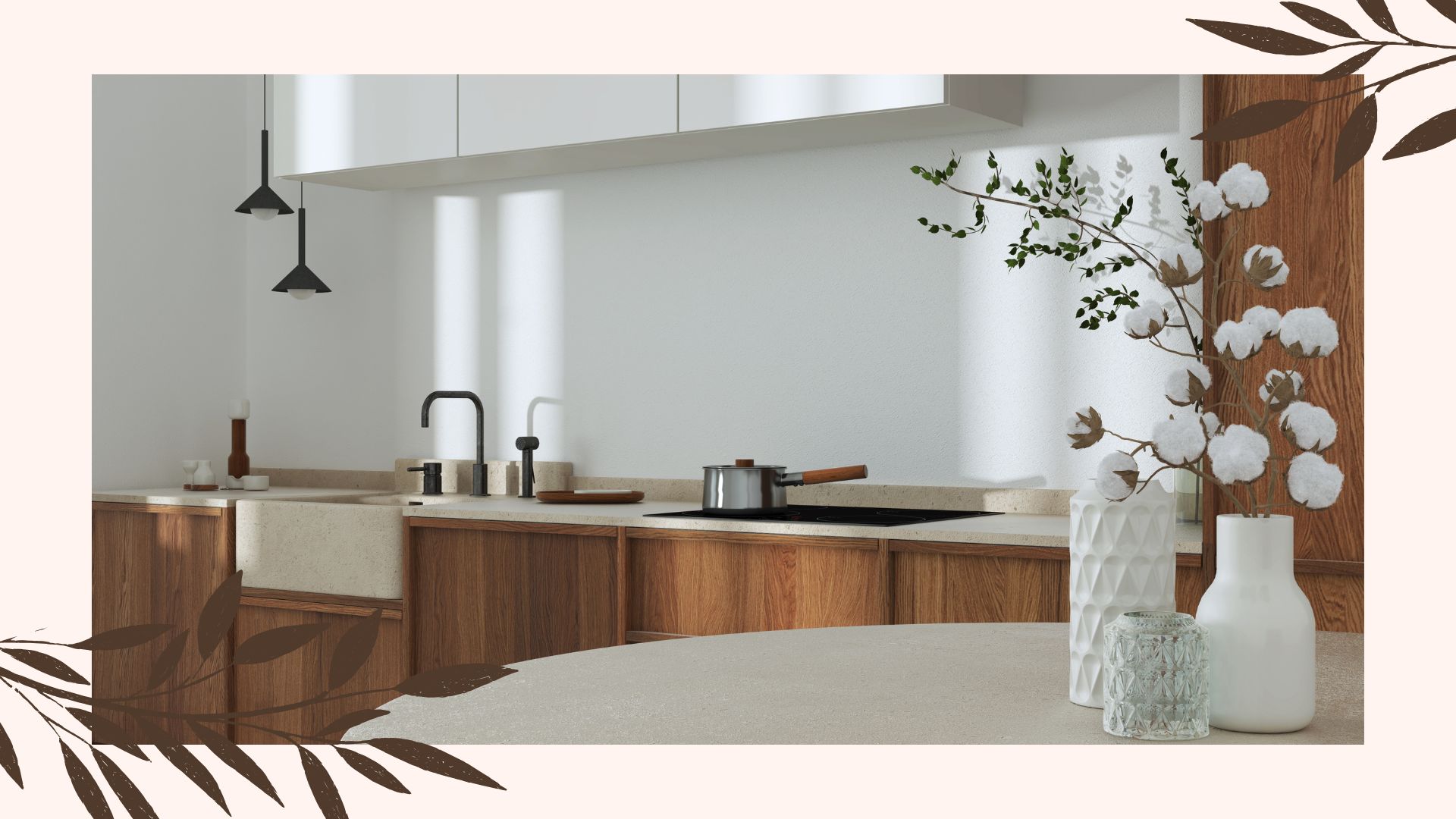
A Japandi kitchen is not only stylish but also functional, which is why it’s become such a popular aesthetic with homeowners.
Not sure what Japandi is? The term first appeared around 2016, and as the name suggests, it’s a design mix of Japanese and Scandinavian styles.
It’s influenced by two practices — the ancient Japanese philosophy of wabi-sabi and the Scandinavian concept of hygge — both of which value simplicity, contentment, and well-being. Both ways of living also embrace nature, all of which can be translated into the look and feel. Think of minimal lines combined with simple, practical items that genuinely enhance life.
“Japandi design is all about functionality and minimalism, with each item within the room having a strong purpose, whether that’s a day-to-day function or decorative appeal,” says Elina Enqvist-Twomey, from bathroom and kitchen manufacturer, GROHE.
Japandi also emphasises sustainability, making it not only a stylish choice but also an eco-friendly one. All of these elements work outstandingly in kitchen design.
Japandi kitchen ideas: 10 interior design tips
Just like Japandi bedroom ideas, a Japandi kitchen uses warm natural materials and is all about neutral shades and minimal clutter. Lighting is also important and, when combined with the other elements, creates a cosy, practical kitchen that you won’t want to leave.
“Japandi works brilliantly well in open-plan living areas, which are popular in the UK now,” says Dawn Filkins, head of creative at Smile Kitchens.
Sign up to our free daily email for the latest royal and entertainment news, interesting opinion, expert advice on styling and beauty trends, and no-nonsense guides to the health and wellness questions you want answered.
She continues: “It is also a very calming style that can be easily replicated through a combination of textures and finishes."
If that sounds enticing, here are some expert tips on how to get a Japandi kitchen.
1. Keep it neutral

The first step to creating a calming, minimal environment is to stick to a neutral colour palette on walls and kitchen units. Soft shades such as beiges and even pale greens, such as pistachio green, help in making a kitchen cosy – something that’s not traditionally associated with clean, minimal kitchens.
Katie Seidler, interior designer at @hello_haus, advises sticking to neutral shades with warm undertones, otherwise, you risk losing the cosy element.
“Keep it neutral but warm,” she advises. “Japandi is the fusion of Scandinavian muted tones with the earthy colours of Japanese design. Soft beiges, taupes, and mushroom tones will make your kitchen feel cosy. It’s important to pick colours with warm undertones rather than cooler options.”
These tones not only help soften the kitchen environment, but they also allow for flexibility with adding accessories and textiles in coordinating accent tones.
Don’t forget you can also bring soft muted colours into the kitchen through tiles and different budget kitchen updates. This is perfect if you prefer to stick to the best white paint colours on walls or cabinets.
2. Choose the right kind of cabinets
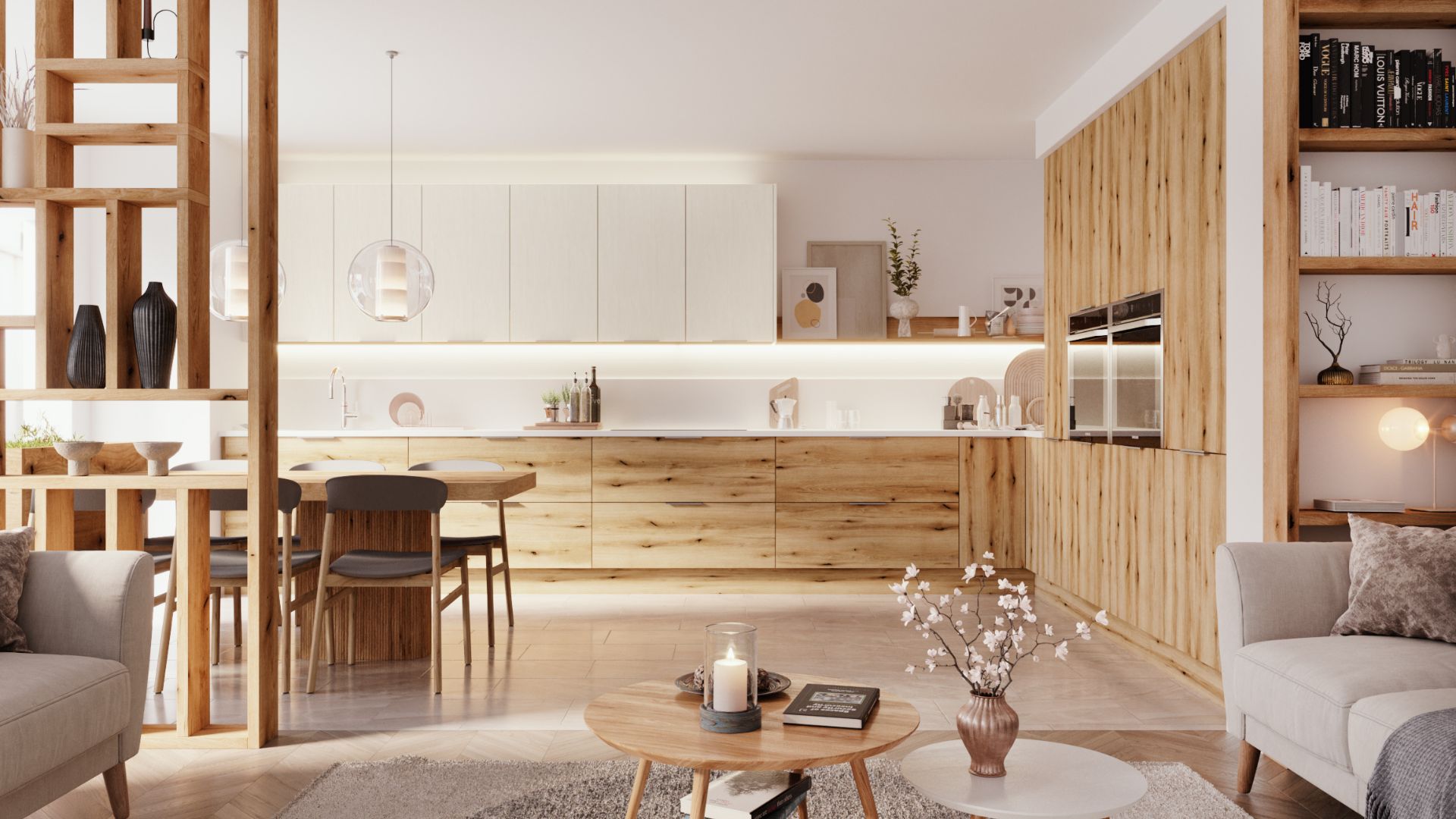
An obvious material for your Japandi kitchen cabinets is wood, which will add a natural element to the room, while also looking warm and inviting. It's a similar theme to the Minimaluxe trend that continues to be popular.
“Wood finishes offer warmth and soft texture to prevent the space from feeling too sterile,” advises Chris Dance, Head Designer and Director at InHouse Inspired Room Design.
“For added texture, choose a cabinet front with vertical wooden ridges, or combine wood flooring and cabinetry in different tones for a warm, natural feel.”
David also advises ditching the handles to provide a clean, sleek feel that fits in with the minimal Japandi aesthetic.
If you’re watching the pennies and can’t afford to install a whole new kitchen, Dawn from Smile Kitchens says new doors can make a real difference.
“Consider replacing your kitchen cabinet doors with a Japandi-inspired style, such as our Löfte range in Oak. The door and finish scream Japandi and on their own will help to evoke the feeling you’re searching for,” she says.
3. Go for natural worktops
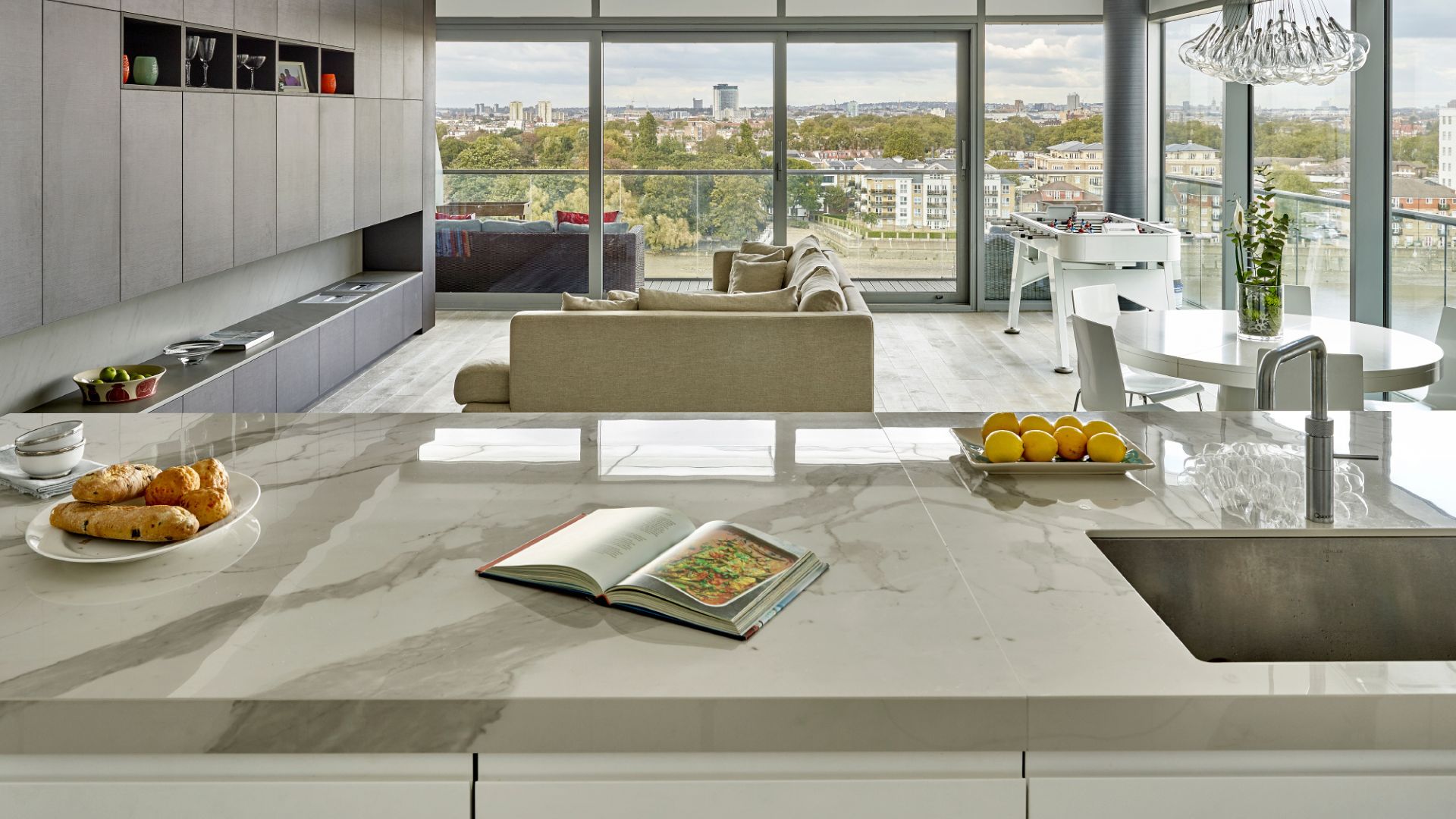
Japandi is very much about choosing quality craftsmanship over cheaper buys that won’t stand the test of time. And nowhere is this more important than with worktops. These are super high-traffic areas and need to last.
Countertops made out of natural materials are one of the big kitchen trends for 2025, which is perfect for this trend. A quartz worktop is not only hardwearing and low maintenance but also has a natural feel.
Choose a marble or granite design in muted tones to ensure a calm, coherent look throughout your Japandi kitchen.
4. Bring the outdoors in
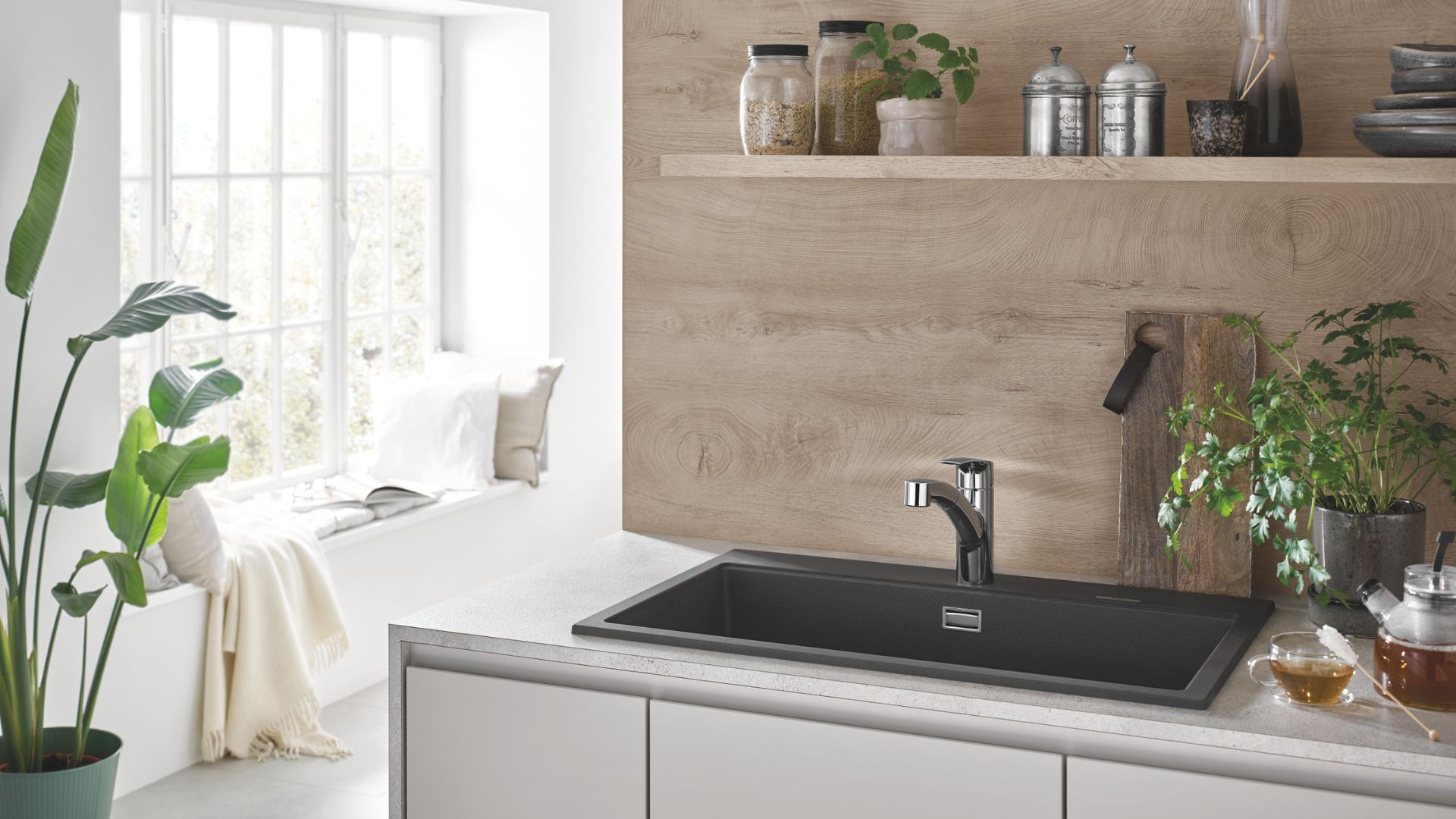
While plants and foliage may seem more natural in a Japandi bedroom, they can also look super stylish in the kitchen, especially when teamed with muted, natural wall colours and wooden cabinets. Japandi is all about seeing beauty in simple, raw things, and plants are very much an integral element of this.
“Bringing the outside in is key to Japandi,” says Dawn. “Add natural elements and textures such as wood and stones. Also, make sure to add lots of plants - both living and dried out.”
Don’t have green fingers or are not sure what will grow in your kitchen? The best places to buy plants online will give you all the advice you need, but in general, aloe vera, ivy, and spider plants will thrive in most environments.
Accessories can also help bring nature inside and are a cheap way of giving your kitchen a Japandi makeover.
“If you can’t go all-out on a brand new Japandi kitchen, you can add some elements of Japandi in your existing kitchen by incorporating some rattan-style pieces,” advises George Burrows at HomeHow.co.uk.
“Things like rattan light shades and a rattan fruit bowl can help to provide some of the Japandi styles that you’re looking for.”

RRP: £52 | This plant comes highly recommended, with around 35 out of 38 reviews giving it five stars. A Kentia palm is ideal if you want a plant with a little height and one that can happily reside in a corner of the kitchen without taking up too much space.
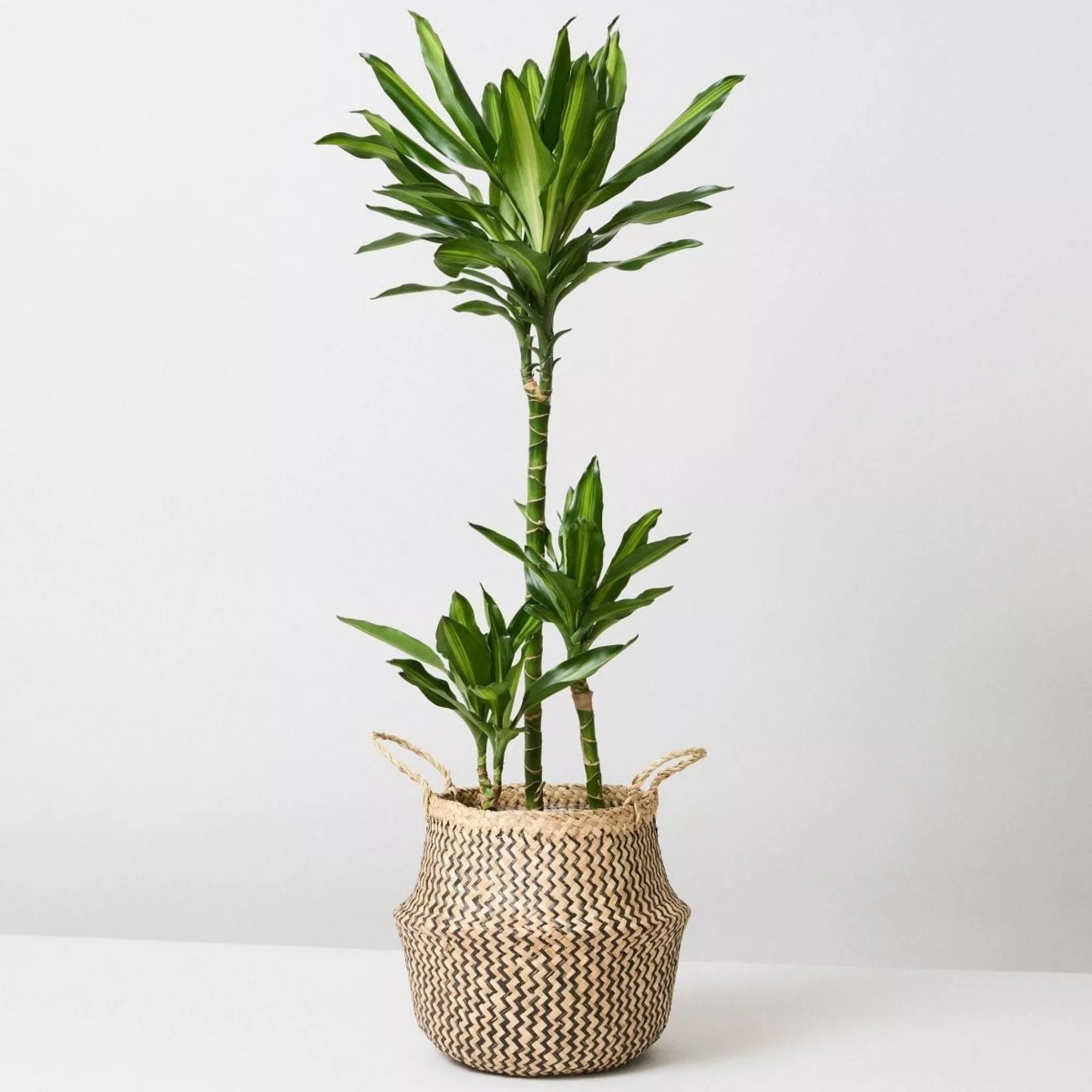
RRP: £95 | It's no surprise this plant is a best-seller at The Stem, it truly has it all. There is leafy foliage and a nice height similar to palm plants, it's the ideal way of adding a little colour to your Japandi kitchen.

RRP: £16 | Looking for a low-maintenance leafy friend? Learning how to care for a snake plant won't stress you out, and it has impressive growing potential, so it's a win-win. This one from B&Q comes in a grow pot so you can choose you're desired permanent pot that suits the Japandi style.
5. Create an invisible kitchen
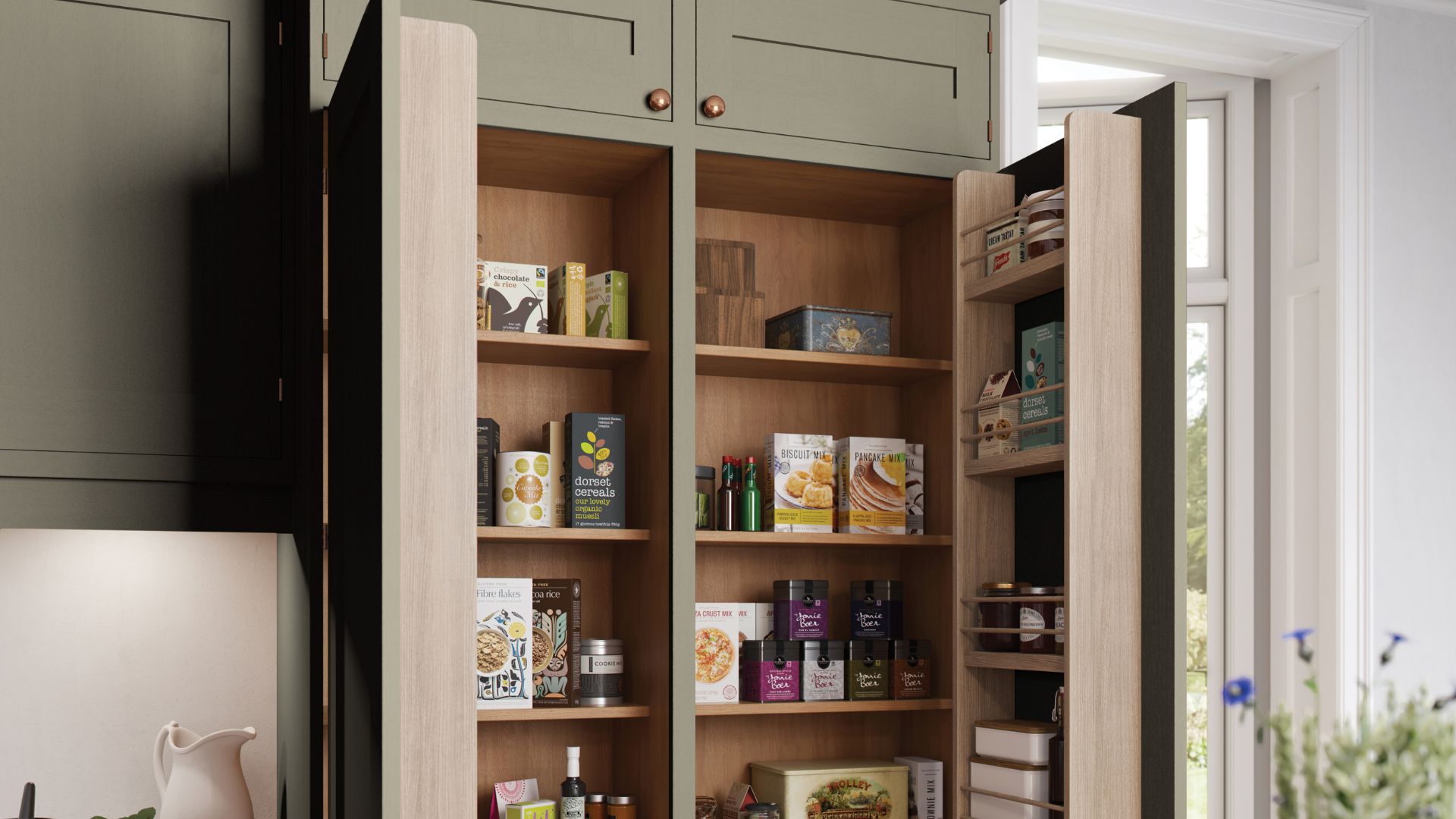
The ‘invisible’ kitchen has been one of the big modern kitchen trends – and it marries well with the Japandi theme.
“We all have ‘stuff’, but to keep the Japandi style true, look to keep larger areas free and clean,” says Andy Briggs, interior designer at Optiplan Kitchens.
“Japandi styles are easy to achieve in a kitchen, using larger cupboards and pantries to hide away any clutter, and keep your worktops clear.”
The true Japandi kitchen will also keep all appliances hidden, so if you’re having new kitchen cabinets installed, think about creating places to hide your microwave and fridge freezer.
You can also go for an under-mounted sink – a kind of sunken sink if you will – to add to the spacious, minimal feel. And if you’re looking to make a small kitchen look bigger, hidden storage is your friend, so it’s perfect for tiny kitchens.
6. Time to declutter

Wondering how to organise your kitchen so it’s sleek and minimal? Sue Spencer, professional declutterer at A Life More Organized, and a KonMari master consultant, recommends a good declutter if you’re aiming for a Japandi kitchen.
“I always recommend decluttering first, so you make sure that you’ve only got the things you need in your kitchen. I like to keep kitchen cupboards organised so you can see, reach and easily use everything you need.”
Once you’ve decluttered and got your fabulous storage space, Sue recommends storing similar items together, making it obvious where they need to go after they’ve been used.
The danger spot for a minimal kitchen is often the surfaces, but Sue has an idea for that as well. “Kitchen surfaces are not very useful 'work' tops if you have to clear them before using them!” she says.
“I recommend placing a plant or decorative item on the worktop to help keep the surface clear. Once you’ve made a conscious decision to make a space look nice, you’re less likely to leave papers and other bits and pieces there.”
Her other advice is to do a quick tidy of surfaces before bed every night. “Getting into a routine like this means that the clutter doesn’t build up over several days and you keep on top of it,” she says. “Once you get used to it, you’ll find that you naturally want to keep your space clear. “
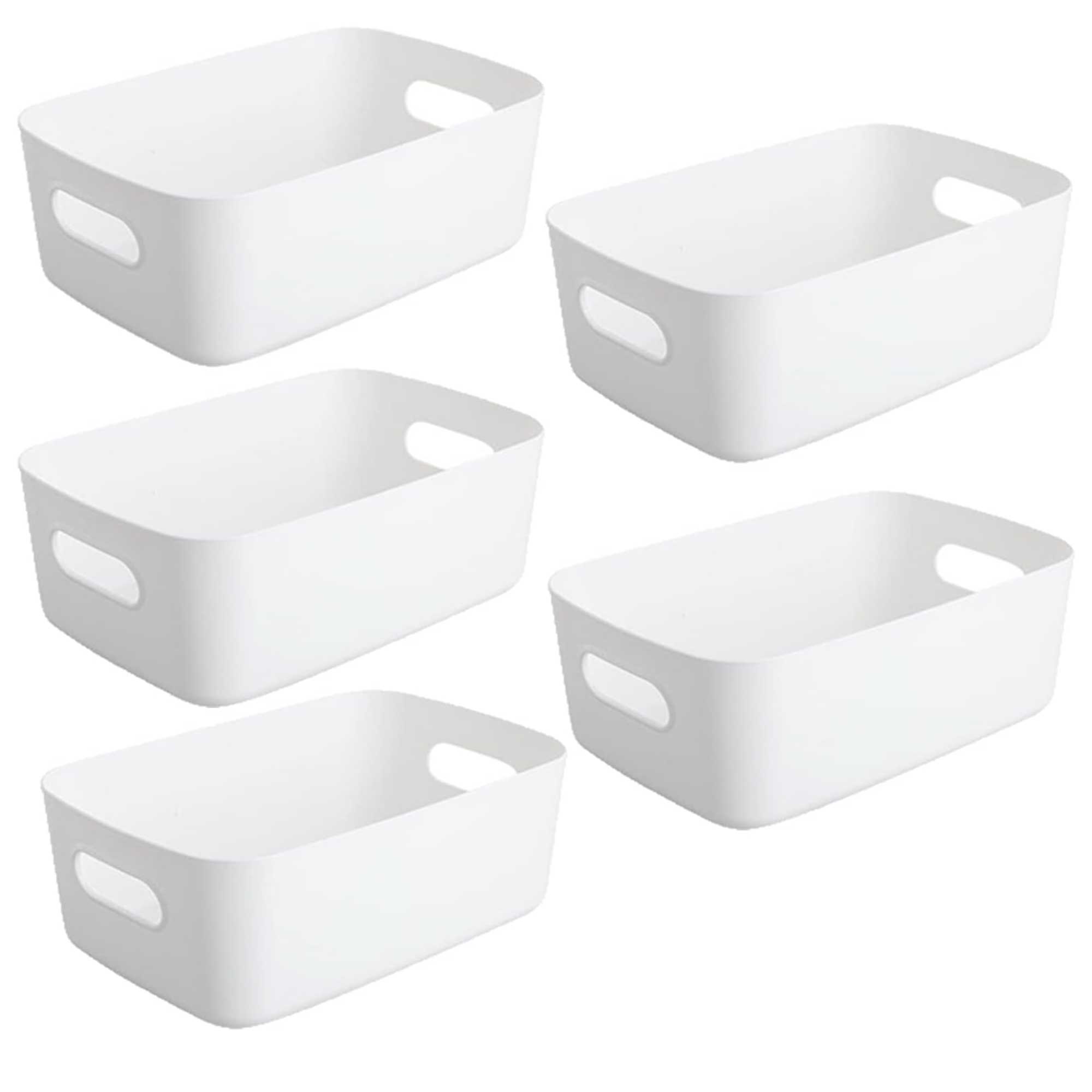
RRP: £12.99 | Fitted with handles, to ensure they can be easily moved, this pack of 5 storage baskets is ideal for cupboards filled with cleaning products and loose goods.
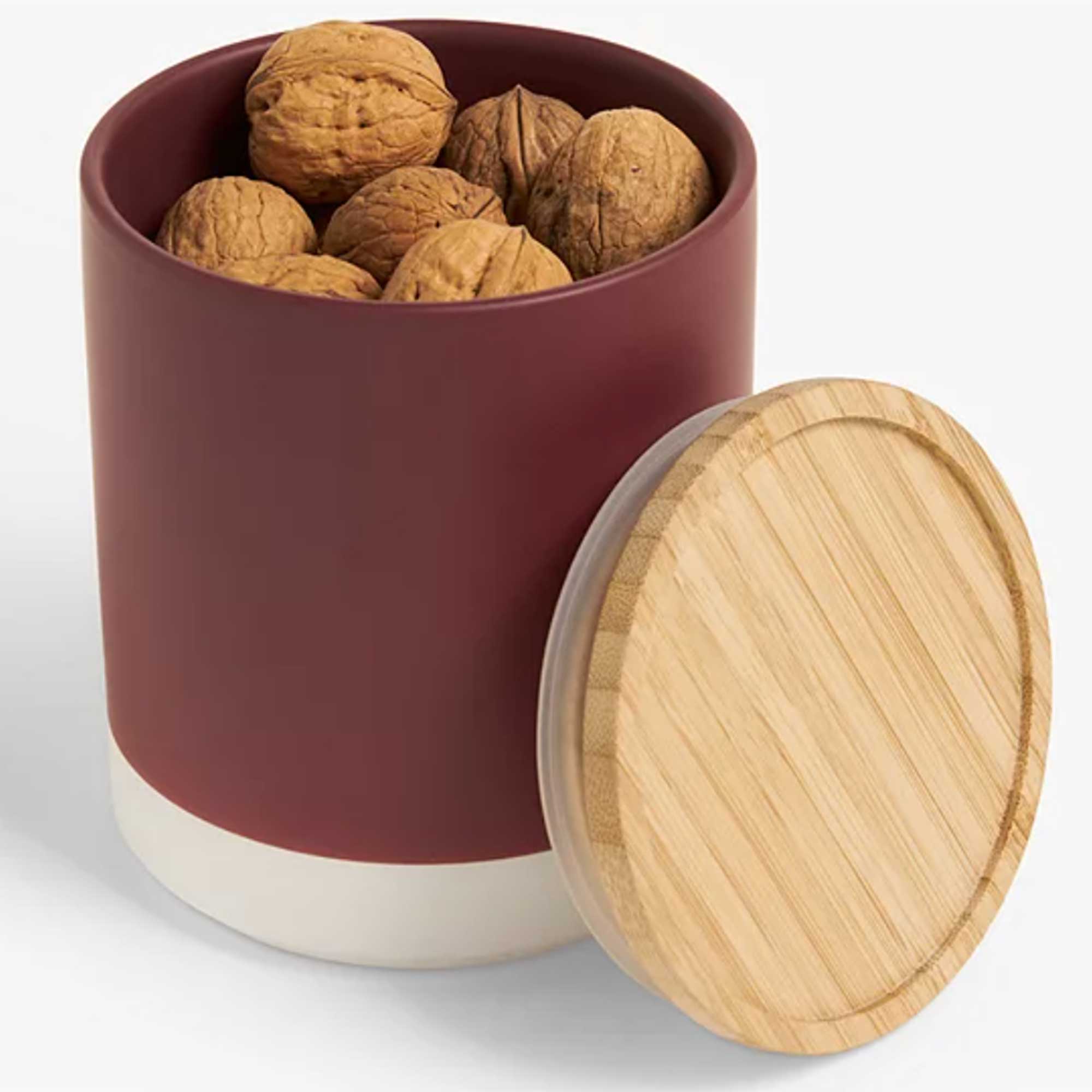
RRP: £12 | Whether on a countertop or in an organised pantry, this stylish jar from John Lewis is perfect for a Japandi kitchen. Seen here in on-trend tone of Damson, this jar is available in 6 other pleasing colours.
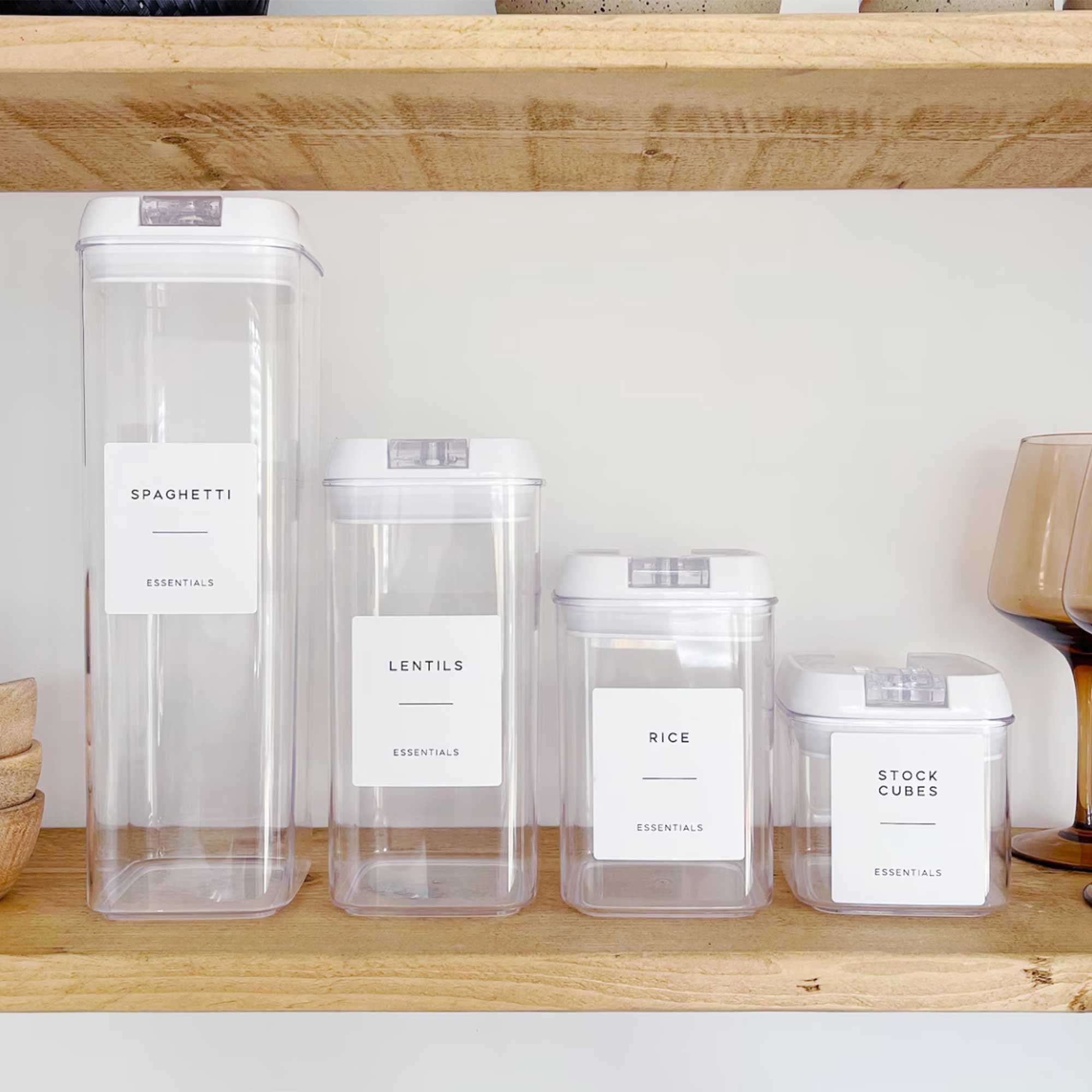
RRP: £7 | These square clear plastic storage jars feature airtight flip-lock lids to guarantee freshness. The minimalist storage containers by The Shelf Life Shop also feature personalised labels to restore order to your food supplies.
7. Play with textures
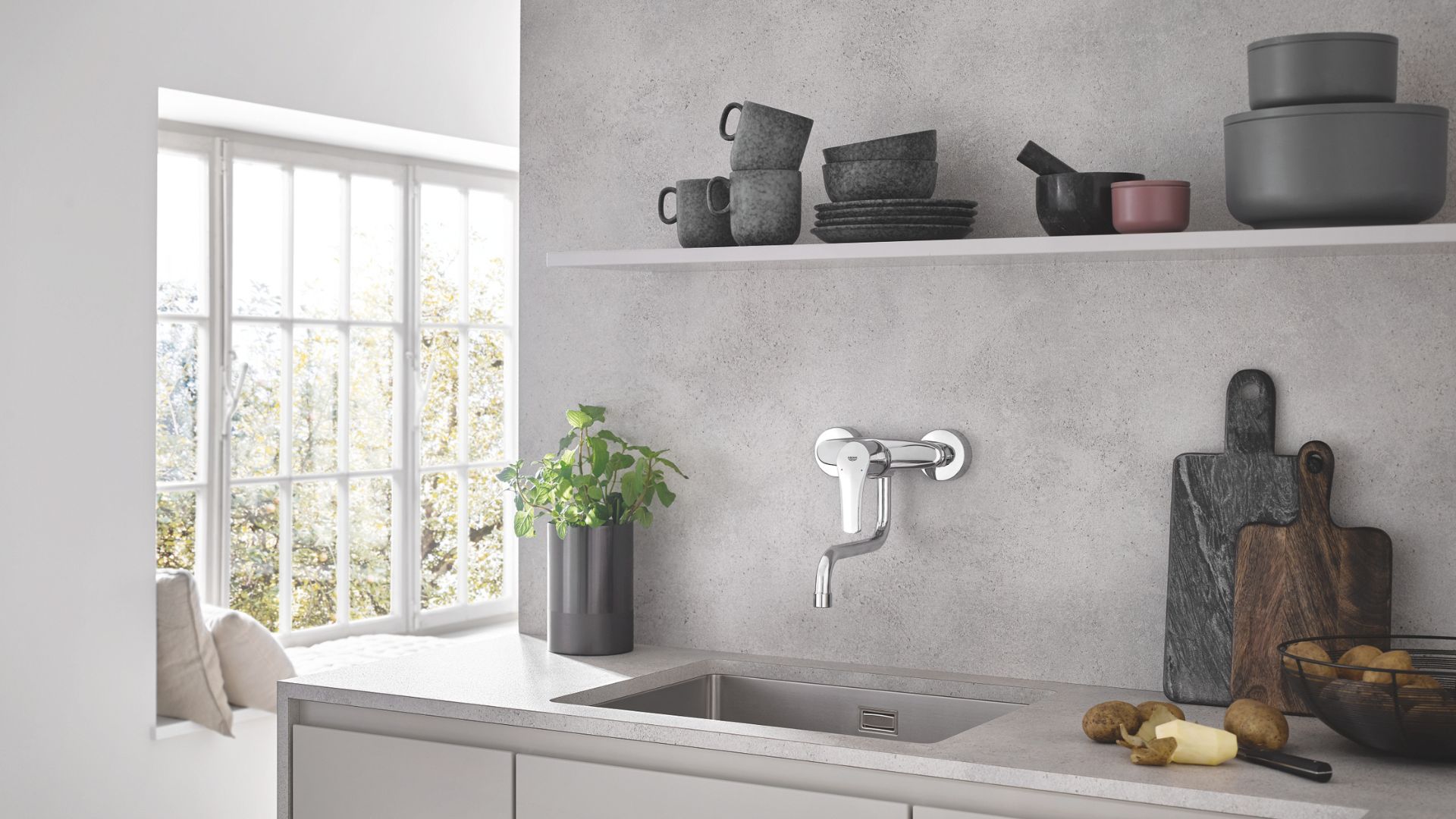
To make your kitchen feel warm and inviting, the texture is key. “Incorporating warmer materials such as natural wood and soft fabrics will support and emphasise the notion of comfort, creating the ideal sleek and functional, yet inviting space,” advises Elina.
An easy way to do this is with different textures and fabrics. Yes, there may not be as much opportunity in a kitchen as there is in, say, a living room to do this, but there are still options to make the room cosy, such as curtains, tablecloths, and even rugs. All of these can help inject warmth into a cold kitchen, literally and emotionally.
Katie says accessories, in particular tableware, can also add interest and texture to the overall look of your kitchen.
“Think about softening those clean lines of Scandi design with irregular shapes, unglazed finishes on your plates and bowls, and textured, reeded glassware — the more 'unfinished' the more it will play into this look,” she advises.
8. Don’t neglect the lighting

Making kitchen lighting an afterthought is one of the most common kitchen design mistakes. Spotlights that offer glimpses of light in key areas or bright overhead lights that make the area practical, but often take away any warmth or character, are functional, but not very pretty.
Katie says this trend needs warm, ambient lighting and can be done just as you would in other rooms in your house to create a layered lighting scheme.
“Lighting is key to setting the tone in any room — this can be done with shelf lighting or a table lamp on a worktop to give you an alternative to harsh kitchen spots at night,” she says. “Think about natural materials like wood and linen for your lighting choices.” All of which are prominent lighting trends for 2025.
9. Dress your windows

Cosiness is a very important element in Japandi style, and while you may automatically reach for blinds when it comes to your kitchen, curtains can make a difference. Not only do they make any room look cosier, but they also help to keep the heat locked in and keep your kitchen warm and inviting.
Whether you choose blinds or curtains, go for natural fabrics such as linen in muted shades. As layers work so well in Japandi design, a heavier curtain over a voile layer works well, or similarly, natural-colored blinds covered by slightly see-through curtains will help keep your kitchen private, while also softening the lines of the window.
And if blinds are the only option due to perhaps a lack of space, go for natural options such as rattan or wood to complement the outdoor feeling of your kitchen.
10. Add unique styling touches

While your Japandi kitchen shouldn’t be stuffed full of appliances and items, adding a few finishing touches, such as some ornamental vases or art, can help complete the look. It's also a great way of adding personality to your home, making it feel less empty or clinical.
“Both Japanese and Scandinavian design focus on function, so try not to overcrowd your kitchen,” advises Kate.
“Layering is very important to consider for this trend and is great to balance out the hard lines of a very functional space like a kitchen. Style your kitchen shelves or surfaces with different textures and shapes in a muted palette and layer your materials like linen, wood and ceramics, but keep it uncluttered.”

RRP: £42 | This natural marble effect bowl is perfect as an ornamental piece or even a fruit bowl for your kitchen. It won't clash with your Japandi colour theme and will introduce another neutral texture.
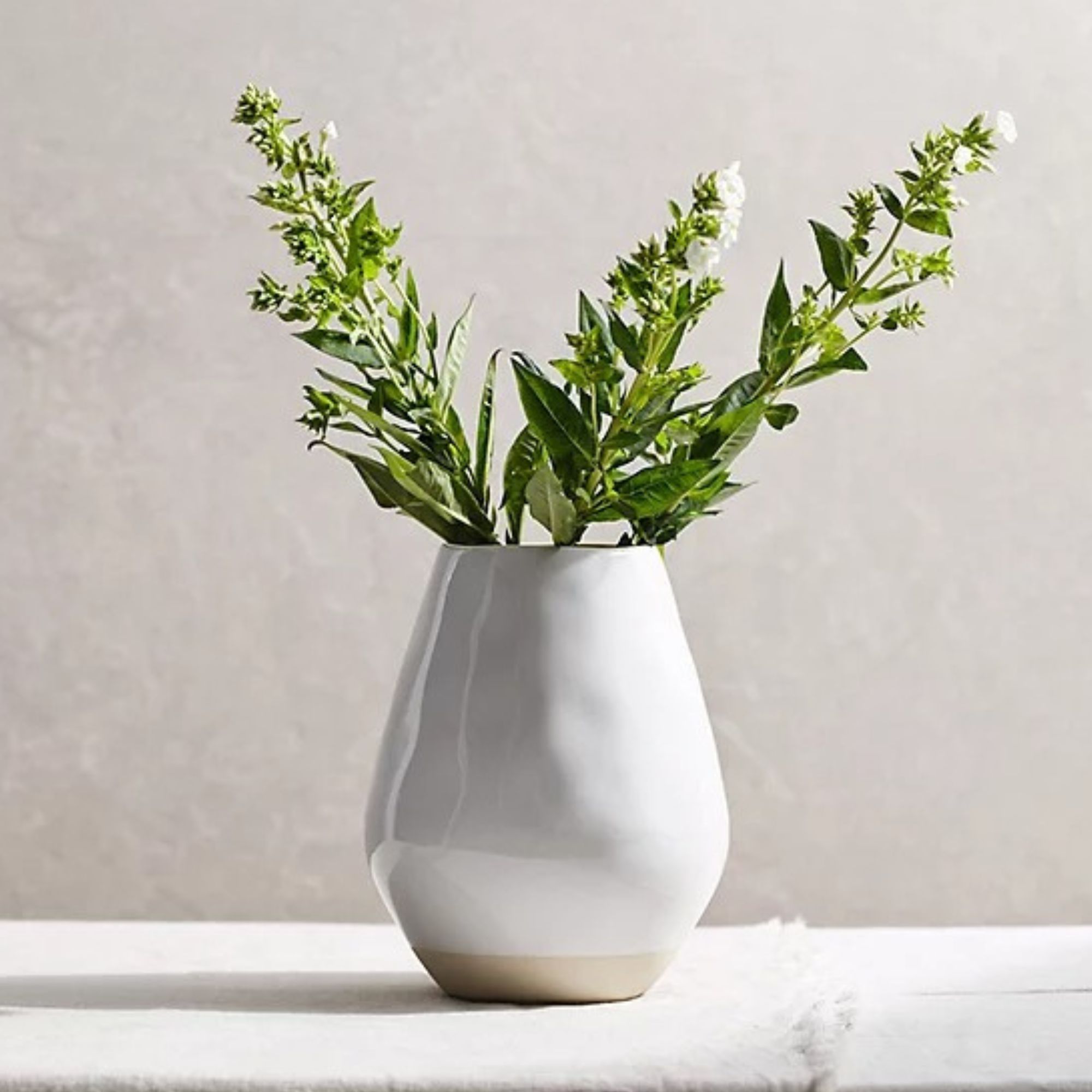
RRP: £38 | This vase is ideal for top-heavy bouquets as its pear-shaped design offers a sturdy base. It's also perfect for being centre stage in your Japandi kitchen thanks to its effortless simplicity and organic shape.

RRP: £65 | This best-selling design is not only rechargeable and wireless, but it is also dimmable, which makes it perfect for achieving that warm Japandi lighting. It would look perfect on a de-cluttered shelf or next to your favourite appliance.
FAQs
What are the rules for Japandi design?
Trying out key interior design trends can feel a little daunting sometimes; however, the Japandi trend is all simplicity, so it's one of the easier trends to try out.
“Japandi style has always been about balance. It unites the sophisticated restraint of Japanese design with the soft minimalism of Scandinavian interiors. However, since the Japandi style first emerged, it has evolved, and in 2025, it’s more expressive and layered than before," explains Lena Gierasinska, Head of Product and Displays at Barker and Stonehouse.
She adds, "Earlier interpretations were quite pared-back, but the latest iteration is warmer and heavier on personality yet still stylish and emotionally grounding."
If you're wanting to bring positive energy into your home this year, the Japandi trend and its relaxing meaning.
What is the colour scheme of a Japandi kitchen?
Many hues found in the colour palette of a Japandi kitchen are also present in this year's interior colour trends. The main reason for this, aside from them being versatile, is that their extremely timeless shades that you'll never grow tired of.
Victoria Robinson, style and trend expert at Hillarys, says, "When it comes to colour schemes, Japandi kitchens are defined by their muted, nature-inspired palettes. Think soft whites, warm greys, taupe, and beige as the foundation, complemented by accents of charcoal, muted greens, or deep blues.
"Light to medium wood tones, such as ash or oak, are commonly used for cabinetry and furniture, sometimes contrasted with darker woods for added depth. The goal is to create a calming and harmonious environment that feels timeless and welcoming," she adds.

Victoria joined Hillarys in 2013 when she designed, developed, and launched the company’s first exclusive designer Roman blind and curtain capsule collection. Victoria is passionate about interior design trends and keeps abreast of new fashions. She then loves to share the latest looks with customers.
Is Japandi still trending in 2025? And why?
Although the trend first began almost 10 years ago in 2016, this serene, welcoming decor trend is going nowhere soon.
"Japandi continues to be a strong trend in 2025, and for good reason. Its enduring popularity can be attributed to the growing desire for homes that provide both tranquillity and functionality," explains Victoria.
"As our living spaces become more central to our daily lives, people are drawn to the calming, uncluttered aesthetics and sustainable principles at the heart of Japandi," she continues. "It’s a style that appeals to those who value intentional living, natural materials, and a harmonious blend of cultures. Rather than being a fleeting trend, Japandi has established itself as a timeless design approach that adapts beautifully to modern needs."
So, if you're looking to redecorate your kitchen, the Japandi style is one you can invest in.
Why not try out some Japandi living room ideas too? This is a great style for the space you go to retreat, rest and relax. The colour palette, cosy lighting and soothing fabrics couldn't be better for the room.
With over 25 years’ experience in journalism, Jayne has written about a variety of subjects. She spent the start of her career within the world of film, interviewing Hollywood stars, attending premieres and lusting after red carpet outfits, and then moved into fashion, launching websites for big magazines such as Look, Woman’s Own and Wedding and working with top fashion brands such as Westfield, LK Bennett and Hunter.
Career highlights include dressing up as Kylie (in gold hot pants!) for a national newspaper and working on big fashion events alongside Giles Deacon, Henry Holland and Naomi Campbell.
- Emily SmithDigital lifestyle writer
